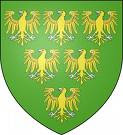I’ve been looking forward to this book for some time, and it
was well worth the wait. The Clare
sisters tells the story of Edward II’s three nieces, from his sister’s marriage,
Joan of Acre, to Gilbert ‘the Red’ Clare, Earl of Gloucester and Hertford. The Clare sisters were Eleanor, Margaret and
Elizabeth. Their brother Gilbert was
killed at the Battle of Bannockburn in 1314, thus ensuring his sisters inherited
his wealth and lands. The three sisters
lived remarkable lives, and were indeed used as pawns of the crown, most
noticeably by their uncle, Edward II, who used their marriages to bring his
favourites into his family and bind them close to him. Although it was his father, Edward 1st,
that arranged the marriage of the eldest, Eleanor, to Hugh Despencer the Younger,
and long before he became the favourite of Edward II.
Kathryn’s book draws on the excellent research she is known
for, and although there is scarce information on the feelings of the sisters
and their marriages, Kathryn doesn’t make the mistake of putting words into their
mouths. So why have no idea how the
sisters felt about their marriages, but they certainly new their duty and what
was expected of them. They were pawns in
the marriage game.
The Clare sister I
am most interested in, of course, is Margaret, wife of Piers Gaveston. She was an excellent bride for Piers. Edward used Margaret to bring Piers into his
family, under his protection, and the couple were made the Earl and Countess of
Cornwall. We don’t know how Margaret
felt about marrying Piers, or the relationship between Piers and Edward
II. However, there is no reason to
suppose Margaret was upset or displeased with the match. Why should she be? She had married quite possibly the most
influential and powerful man in the country – although this was dependent on
her husband’s relationship with her uncle, Edward, and there is no doubt of the
devotion and love that Edward felt for Piers.
For Margaret, it was a spectacular match, and there is no reason to
think she was unhappy. She dutifully
followed her husband into exile in Ireland, and as Warner points out, she may
well have enjoyed having her husband to herself. No doubt being Countess of Cornwall was
prestigious for her, and being a few years younger than her husband, she was an
ideal companion for Edward’s wife, Isabella of France. What a strange Christmas 1309 at Langley
might have been – with perhaps Isabella and Margaret left to their childish chatter
while their husbands made the most of their time together. Tragically, events were to overtake everyone,
and after Piers was unlawfully killed in 1314, Margaret was left a widow with a
young baby daughter, Joan Gaveston.
Edward cared for both his niece and great niece, and it was to be
expected that Edward ensured Joan Gaveston was well cared for by his sister
Mary, a nun at Amesbury.
Remarkably,
Edward later married Margaret to another of his favourites, Hugh Audley, whilst
the 3rd sister, Elizabeth, after a short first marriage, married another
of his favourites, Roger Damory. What
makes truly fascinating reading though is Edward’s sudden infatuation with the
husband of his eldest niece, Hugh Despencer.
How and when this happened, we don’t know, and we also don’t know Eleanor’s
role in the relationship. The husbands
of both Margaret and Elizabeth rebelled against Edward and his new favourite
Hugh Despencer – what a complicated set of relationships! Both sisters suffered as a consequence. But Eleanor and her husband Hugh soared in
the King’s favour. Warner raises the intriguing
idea of perhaps Eleanor being the secret mistress of Edward II – it seems
possible in the evidence Warner presents.
The marriage of Eleanor and Hugh seems a happy one, and they produced numerous
children. Both Eleanor and her husband
were ambitious, even to the point of allowing one of their younger children to
be brough up in another noble man’s house from a young baby. Warner points out that Eleanor must have
known how ruthless and grasping her husband was, and she seemingly wasn’t
opposed to his actions. When both her
uncle and husband fell, Eleanor was imprisoned in the Tower, and her sisters
released from their imprisonment. I
found myself disliking Eleanor as the book progressed, which I’m sure wasn’t
Warner’s intention. But the character of
Eleanor Despencer is intriguing – if only there was more evidence available
that makes clear exactly what her relationship was with her uncle – was she his
mistress, or was this a charge levelled at Edward II to blacken the character
of her uncle by portraying him in an incestuous relationship with his niece, or
did she ruthlessly exploit the relationship between her uncle and husband? A fascinating read into the insight of 3
powerful pawns in the marriage game of 14th Century politics.



